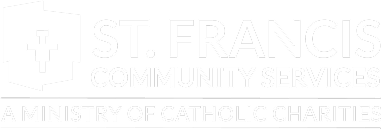St. Francis Community Service empowers low-income multicultural individuals and families to improve their lives.
(Image above: St. Francis Community Services marching in the Stand Up for Women Veterans parade in November, 2018)
Veterans Advocacy Project attorney Stephanie Lummus often spends her Thursdays away from the St. Francis Community Services Catholic Legal Assistance Ministry office. Preparing for City Diversion Court, she assesses the courtroom and remarks, “It’s like the Wild West in here.”
Case managers, prosecutors, lawyers and clients line the courtroom, shuffling back and forth waiting for their turn to meet with the judge. Lummus scans the room for her client, Aleyah Brown, enthusiastically welcoming her when she arrives. Brown is a United States Air Force veteran, a young woman of slight build and quick wit. After returning from her years of service, Brown encountered challenges faced by many veterans including PTSD and mental health issues catalyzed by military service. She experienced unemployment and abuse by a former partner. Her mental health issues and unemployment made it difficult for her to exit her abusive relationship, and she eventually became homeless.
With help from St. Patrick Center programs and her own tenacious nature, Brown has found housing and regained stability in her life. Still, legal issues from her past create a barrier between her present and a brighter future. She is working with Lummus and the Veterans Advocacy Project to remove these barriers to her success.
Approaching Justice with Compassion
To many who have experienced regular courtrooms, Diversion court looks significantly different. The court is designed to assist defendants with low-level offenses and co-occurring disorders to keep sentences off their records and connect them with needed social services. The judge might allow defendants to perform community service instead of paying fines. Co-occurring disorders and progress towards a goal (such as remaining in housing or avoiding other offenses) are also taken more into consideration than in a regular courtroom. There are disadvantages to Diversion Court: some argue this alternate court structure languishes justice by forcing individuals to wait months for their outcome, also throwing out the regular structure of the law. But as in a regular court, an experienced attorney is one of the true keys to success.
As a veteran herself, Lummus makes sure that the Veterans Advocacy Project lives up to its name. In a small room next to the court, Lummus maintains a lighthearted mood as she explains the charges against her client. Brown faces two legal issues: a minor nuisance charge and outstanding traffic violations which suspended her driver’s license. Though these are minor ordinance violations charges, they impede Brown’s ability to find work and to live without extreme stress. They bring worry over transportation and the cost of fines and fees, many of which could have been avoided if Brown had more support in navigating the municipal court system and in her transition back home after her service.
Traffic tickets spread over multiple municipalities are difficult to navigate without the aid of a lawyer, and like many veterans in poverty, Brown could not afford one. These traffic tickets often accumulate and leave individuals unable to pay, and eventually result in a warrant for their arrest. Because of traffic issues, individual’s lives can be disrupted for years. Lummus knows this firsthand. “If you clear a municipal warrant, you have improved a life significantly. I’ve had clients who did not want to go to the hospital because of the stigma of a warrant,” says Lummus. While the Veterans Advocacy Project intervened before this was the case for Brown, her story often is accompanied by such hardship.
Lummus discusses the charges and possible outcomes with Brown. Lummus then describes how she will go to each of the municipal governments in which Brown has traffic tickets and advocate for a reduction of the points against her license. With that, Brown should be able to have her license reinstated and be able to exit the court system entirely.
Homeless Female Veterans: A Rapidly Changing Population
Brown’s story is becoming less unique. While the overall veteran homeless population decreased forty five percent from 2009 to 2017, the percentage of female veterans experiencing homelessness rose and is expected to continue to rise. According to the 2017 Annual Homeless Report to Congress the number of homeless female veterans increased by seven percent, compared to one percent for their male counterparts, between 2016 and 2017.[1]
Homeless female veterans don’t fit the same profile as homeless male veterans. Female veterans are much more likely to deal with domestic abuse and are often considered “sheltered homeless,” staying with an abusive partner like Brown did or staying on couches with their family in order to maintain a residence (which is still considered homelessness). Stephanie Ovit, wellness director at Soldier On, a transitional housing coalition for veterans, notes, “They are usually living in vehicles, staying on a friend’s couch, or remaining in a violent relationship in order to not become homeless.”[2] Veteran’s services have not historically been geared towards women, and especially women with children. As this population continues to change, the VA and other services are changing to meet their needs.
About the Veterans Advocacy Project
Providing free counsel to individuals like Aleyah Brown, each of these cases that the Veterans Advocacy Project takes on is focused on reducing extreme stress in veteran’s lives, assisting them with barriers to employment, and helping them exit poverty. More than that, however, the Veterans Advocacy Project creates trusting relationships with clients in order to change the trajectory of their lives.
Last year, Stephanie and her legal assistant, Wade Chatfield, assisted veterans in 1000 municipal matters through the Veterans Advocacy Project. This included cases that:
- removed 162 barriers to obtaining driver’s licenses
- recalled 531 municipal warrants
- removed 349 barriers to employment
While this only describes the legal counsel, the Project goes beyond this to ensure low-income veterans have access to services they need to stabilize their lives and exit poverty. This might include meeting with veterans to help them budget or assisting them with referrals for food, housing, clothing, medical and other socioeconomic services.
The Veterans Advocacy Project is a program of St. Francis Community Services. Our mission is to walk with vulnerable neighbors to create opportunities, build resiliency, and advocate for justice.
[1] https://www.hudexchange.info/resources/documents/2017-AHAR-Part-1.pdf
[2] https://www.research.va.gov/currents/0318-Female-Veterans-comprise-fastest-growing-segment-of-homeless-Veteran-population.cfm

